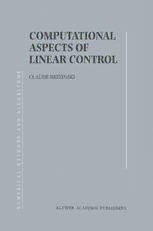Table Of ContentCOMPUTATIONAL ASPECTS OF LINEAR CONTROL
Numerical Methods and Algorithms
VOLUME 1
Series Editor:
Claude Brezinski
Universite des Sciences et Technologies de Lille, France
Computational Aspects
of Linear Control
by
Claude Brezinski
Universite des Sciences et Technologies de Lille,
France
KLUWER ACADEMIC PUBLISHERS
DORDRECHTI BOSTON I LONDON
A C.I.P. Catalogue record for this book is available from the Library of Congress.
ISBN·13: 978-1·4613·7966·9 e·ISBN·13: 978·1-4613·0261·2
DOl: 10.10071978·1-4613·0261·2
Published by Kluwer Academic Publisher.;,
P.O. Box 17, 3300 AA Dordrecht, The Netherlands.
Sold and distributed in North, Central and South America
by Kluwer Academic Publishers,
101 Philip Drive, Norwell. MA 02{)61, U.S.A.
In all other countries, sold and distributed
by Kluwer Academic Publishers,
P.O. Box 322, 3300 AH Dorrlrecht, The Netherlands.
Print~d on acidjre~ paper
All Rights Reserved
C 2002 Kluwer Academic Publishers
Sof tcoYer reprint of \he hardcover 1s\ edilion 2002
No part of this work may be reproduc~, stored in a retrieval system, Of transmitted
in any fonn or by any means, electronic, mechanical, photocopying, microfilming, recording
or otherwise, without wrinen pennission from the Publisher. with the exception
of any material supplied specifically for the purpose of being entered
and executed on a computer system, for exclusive use by the purchaser of hte work.
Contents
INTRODUCTION 1
1. CONTROL OF LINEAR SYSTEMS 3
1 The control problem 3
2 Examples 11
2.1 Hard disk read/write head 11
2.2 Predator-prey 12
2.3 Harmonic oscillator 13
2.4 Toilet control 14
2.5 Control of pH 14
2.6 Nuclear reactor 14
3 Basic notions and results 15
3.1 State-space approach 15
3.2 Frequency-domain approach 16
4 Controllability 23
5 Observability 25
6 The canonical representation 28
7 Realization 30
7.1 Complete realization 31
7.2 Partial realization 36
8 Model reduction 38
8.1 Truncation 39
8.2 Diagonalization 39
8.3 Aggregation 40
8.4 Singular perturbations 41
8.5 Schur decomposition 41
v
vi COMPUTATIONAL ASPECTSOF liNEAR CONTROL
8.6 Balanced reduction 42
8.7 Pade and Lanczos techniques 43
9 Stability analysis 44
10 Poles and zeros 48
10.1 Poles 49
10.2 Zeros 50
10.3 Pole placement 52
lOA Pole-zero cancellation 54
11 Decoupling 56
12 State estimation 58
12.1 Full-order observers 58
12.2 Reduced-order observers 60
12.3 The separation principle 61
13 Geometric theory 62
14 Solving the control problem 63
15 Effects of finite precision 64
Bibliography 67
2. FORMAL ORTHOGONAL POLYNOMIALS 73
1 Definition and properties 73
2 Matrix interpretation 78
3 Adjacent families 79
4 Biorthogonal polynomials 82
5 Vector orthogonal polynomials 84
Bibliography 85
3. PADE APPROXIMATIONS 87
1 Preliminaries 87
2 Pade-type approximants 92
3 Pade approximants 95
3.1 The direct approach 96
3.2 The second approach 97
3.3 Algebraic properties 98
304 Connection to FOPs 101
3.5 Continued fractions 103
3.6 The c:-algorithm 109
4 Error estimation 110
Contents vii
5 Generalizations 117
5.1 Partial Pade approximants 117
5.2 Vector Pade approximants 125
5.3 Matrix Pade approximants 129
6 Approximations to the exponential 131
Bibliography 133
4. TRANSFORM INVERSION 135
1 Laplace transform 135
1.1 Collocation 136
1.2 Rational approximation 136
2 z-transform 140
Bibliography 142
5. LINEAR ALGEBRA ISSUES 145
1 Singular value decomposition 145
1.1 Square matrices 145
1.2 Rectangular matrices 146
1.3 Least squares 147
1.4 Pseudo-inverses 149
2 Schur complement 150
3 The bordering method 151
4 Determinantal identities 151
5 Hankel matrices and related topics 152
6 Stable matrices 154
7 Recursive projection 155
Bibliography 159
6. LANCZOS TRIDIAGONALIZATION PROCESS 161
1 The tridiagonalization process 161
2 The non-Hermitian Lanczos process 166
Bibliography 168
7. SYSTEMS OF LINEAR ALGEBRAIC EQUATIONS 171
1 The method of Arnoldi 171
2 Lanczos method 173
2.1 Matrix approach 174
2.2 Polynomial approach 174
2.3 Recapitulation 176
viii COMPUTATIONAL ASPECTSOF LINEAR CONTROL
3 Implementation of Lanczos method 176
3.1 The recurrences 177
3.2 Computation of the coefficients 180
3.3 The algorithms 180
4 Preconditioning 183
5 Transpose-free algorithms 185
5.1 CGS 187
5.2 BiCGSTAB 188
6 Breakdowns 190
6.1 Avoiding true breakdowns 190
6.2 Avoiding ghost breakdowns 193
6.3 Near-breakdowns 194
6.4 Other Lanczos-based algorithms 195
7 Krylov subspace methods 197
7.1 The methods 198
7.2 The polynomial and rational approaches 199
7.3 Particular cases 203
7.4 Recursive algorithms 204
8 Hankel and Toeplitz systems 207
8.1 Hankel systems 208
8.2 Toeplitz systems 212
9 Error estimates for systems of linear equations 215
9.1 The estimates 216
9.2 Discussion 217
9.3 A numerical example 218
Bibliography 219
8. REGULARIZATION OF ILL-CONDITIONED SYSTEMS 225
1 Introduction 225
2 Analysis of the regularized solutions 226
3 The symmetric positive definite case 229
4 Rational extrapolation procedures 230
4.1 Restricted case 230
4.2 Full case 238
Bibliography 245
9. SYLVESTER AND RICCATI EQUATIONS 249
1 Sylvester equation 249
Contents ix
2 Riccati equation 250
Bibliography 253
10. TOPICS ON NONLINEAR DIFFERENTIAL EQUATIONS 255
1 Integrable systems 255
2 Connection to convergence acceleration 262
2.1 Construction of sequence transformations 262
2.2 The mechanism of extrapolation 268
2.3 Associated partial differential equations 270
2.4 Confluent algorithms 272
Bibliography 272
11. APPENDIX: THE MATHEMATICS OF MODEL REDUCTION 277
1 Model reduction by projection 277
2 Matrix interpretation 279
3 Increasing the dimension 281
4 Construction of the projection 282
5 Transfer function matrices 283
5.1 The modeling error 283
5.2 Moment matching 284
Bibliography 286
INDEX 289

